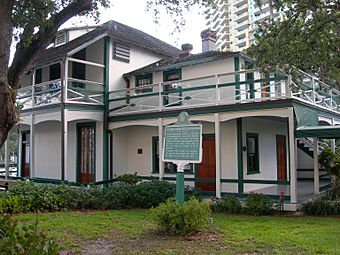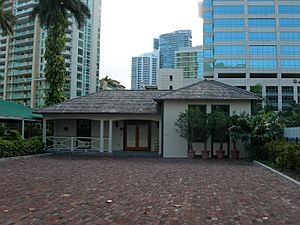Stranahan House facts for kids
Quick facts for kids |
|
|
Stranahan House
|
|
 |
|
| Location | 335 S.E. 6th Ave., Fort Lauderdale, Florida |
|---|---|
| Area | less than one acre |
| Built | 1901 |
| NRHP reference No. | 73000569 |
| Added to NRHP | 2 October 1973 |
The Stranahan House is a very old and special house in Fort Lauderdale, Florida. It was once the home of two important people, Frank and Ivy Stranahan, who were pioneers in the area.
The house was first built in 1901 as a place for trading goods. Later, in 1906, it became the Stranahans' home. It is the oldest building still standing in Broward County. In 1973, it was added to the National Register of Historic Places. Today, you can visit it as a museum to learn about its history. The house offers guided tours and special events. It is located next to the Riverside Hotel.
Contents
Meet the Stranahans
Frank and Ivy's Early Years (1893–1900)
In 1893, a 27-year-old man named Frank Stranahan came to the New River area. He started managing a camp and ferry for his cousin. Soon, Frank began his own trading business. He traded with the Seminole Indians and became known as a fair and honest businessman. Seminole families would often visit his trading post in their dugout canoes and camp there for days.
By 1894, Frank bought ten acres of land for his business. He moved his trading post further west along the river. This spot became the center of the small New River settlement. Frank also became the town's postmaster.
By 1899, the community had grown enough to need a teacher. Ivy Julia Cromartie, an 18-year-old from Lemon City (now Little Haiti), was hired. She earned $48 a month. The community built a one-room schoolhouse for Ivy and her nine students. Frank and Ivy met during the five months she lived and taught there. They got married on August 16, 1900, at Ivy's family home. At that time, married women usually stopped their paid jobs. Ivy did give up her teaching job at the school. However, she continued to teach. She started giving informal lessons to Seminole children at the trading post. She made sure to respect their traditions. This approach helped her become good friends with the Seminole people for the rest of her life.
Growing Fort Lauderdale (1901–1910)
Frank built the Stranahan House we see today in 1901. The first floor was used as a trading post. The second floor was a community hall where people gathered. By 1906, Frank's businesses had grown. He had a general store and a bank. He also built a new building closer to the railroad, which had arrived in 1896. Because of his new businesses, the old trading post was changed into a home for Frank and Ivy.
As Frank's businesses grew, so did the settlement. By 1910, the town had 142 people living there. Frank and Ivy took on many important roles in their growing city. Ivy, for example, helped start the Women's Civic Improvement Association. This group later became the Woman's Club of Fort Lauderdale. Ivy was involved in almost every community cause in the city for the rest of her life.
Challenges and Changes (1911–1929)
The area was renamed Fort Lauderdale in 1911. This new name came from the army forts built during the Seminole Wars. Frank donated land for many public projects in the city. In 1912, Frank sold his trading company. He wanted to focus on real estate and banking. Ivy became the president of the Florida Equal Suffrage Association in 1916. This group worked to give women the right to vote. Because of her strong friendship with the Seminoles, the government asked Ivy for help in 1924. They wanted her to convince the tribe to move to a reservation. She was successful in her efforts.
In 1926, Florida's land boom ended. This meant that many people lost money. Frank faced big financial problems. Two strong hurricanes over the next three years made things even worse. Frank was also very sad because his friends and business partners had lost their money too. On May 22, 1929, Frank was very depressed and unwell. He died in the New River in front of his home.
Ivy's Legacy (1929–1971)
After Frank's death, Ivy continued to live in the house. She rented out rooms to visitors to earn money. Later, she leased the first floor to different restaurants. Ivy slowly returned to her community work. She became a long-time member of the city's planning and zoning committee. She also helped pass the Homestead Exemption law, which helps homeowners. Ivy started the Friends of the Seminoles group. She also founded local chapters of the Red Cross and Campfire Girls in Broward County.
Ivy lived in her home until she passed away on August 30, 1971, at 90 years old. She left the house to the Seventh Day Adventist church, where she had been a member since 1915. The Fort Lauderdale Historical Society bought the house in 1975.
The Stranahan House Today
Building the House (1901–1928)
Frank built the two-story house in 1901. The first floor was used as a trading post. The second floor was a community hall. In 1906, Frank changed the house to make it their family home. Bay windows were added, and gas lights were likely put in at this time. The second floor probably remained an open space, with stairs on the outside. In 1913, the house had another big renovation. An inside staircase was added, and the house got electricity. Water towers were installed in 1915. It is believed that indoor plumbing was also added then.
A Museum for Everyone (1929–Present)
After Frank's death in 1929, Ivy continued to live in the house. She rented out rooms and later leased the first floor to restaurants. The last restaurant was called the Pioneer House Restaurant. Ivy died in 1971. She left the house to the Seventh Day Adventist Church. The church registered the house with the National Register of Historic Homes in 1973.
After the last restaurant closed, the Historical Society of Fort Lauderdale bought the house from the Seventh Day Adventists in 1979. For the next four years, a big project began to restore the house. They wanted it to look like it did in 1915. In 1981, the Stranahan House became its own organization. It had a separate board of trustees. The house opened to the public in the spring of 1984. Today, the house offers daily tours.
See also
- Fort Lauderdale Woman's Club: An organization Ivy Stranahan helped lead.
- National Register of Historic Places listings in Broward County, Florida




